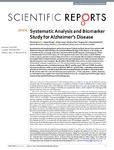Systematic Analysis and Biomarker Study for Alzheimer's Disease
| dc.contributor.author | khazaeli, Shahab | |
| dc.contributor.author | Wang, H | |
| dc.contributor.author | Long, J | |
| dc.contributor.author | Pan, Genhua | |
| dc.contributor.author | He, T | |
| dc.contributor.author | Anichtchik, Oleg | |
| dc.contributor.author | Belshaw, Robert | |
| dc.contributor.author | Albani, D | |
| dc.contributor.author | Edison, P | |
| dc.contributor.author | Green, EK | |
| dc.contributor.author | Scott, J | |
| dc.date.accessioned | 2018-12-12T13:43:23Z | |
| dc.date.issued | 2018-11-26 | |
| dc.identifier.issn | 2045-2322 | |
| dc.identifier.issn | 2045-2322 | |
| dc.identifier.other | ARTN 17394 | |
| dc.identifier.uri | http://hdl.handle.net/10026.1/13026 | |
| dc.description.abstract |
<jats:title>Abstract</jats:title><jats:p>Revealing the relationship between dysfunctional genes in blood and brain tissues from patients with Alzheimer’s Disease (AD) will help us to understand the pathology of this disease. In this study, we conducted the first such large systematic analysis to identify differentially expressed genes (DEGs) in blood samples from 245 AD cases, 143 mild cognitive impairment (MCI) cases, and 182 healthy control subjects, and then compare these with DEGs in brain samples. We evaluated our findings using two independent AD blood datasets and performed a gene-based genome-wide association study to identify potential novel risk genes. We identified 789 and 998 DEGs common to both blood and brain of AD and MCI subjects respectively, over 77% of which had the same regulation directions across tissues and disease status, including the known <jats:italic>ABCA7</jats:italic>, and the novel <jats:italic>TYK2</jats:italic> and <jats:italic>TCIRG1</jats:italic>. A machine learning classification model containing <jats:italic>NDUFA1</jats:italic>, <jats:italic>MRPL51, and RPL36AL</jats:italic>, implicating mitochondrial and ribosomal function, was discovered which discriminated between AD patients and controls with 85.9% of area under the curve and 78.1% accuracy (sensitivity = 77.6%, specificity = 78.9%). Moreover, our findings strongly suggest that mitochondrial dysfunction, NF-κB signalling and iNOS signalling are important dysregulated pathways in AD pathogenesis.</jats:p> | |
| dc.format.extent | 17394- | |
| dc.format.medium | Electronic | |
| dc.language | en | |
| dc.language.iso | en | |
| dc.publisher | Nature Research (part of Springer Nature) | |
| dc.subject | Alzheimer Disease | |
| dc.subject | Biomarkers | |
| dc.subject | Blood | |
| dc.subject | Brain | |
| dc.subject | Case-Control Studies | |
| dc.subject | Cognitive Dysfunction | |
| dc.subject | Genome-Wide Association Study | |
| dc.subject | Humans | |
| dc.subject | Machine Learning | |
| dc.subject | Mitochondria | |
| dc.subject | NF-kappa B | |
| dc.subject | Nitric Oxide Synthase Type II | |
| dc.subject | Ribosomes | |
| dc.subject | Sensitivity and Specificity | |
| dc.subject | Signal Transduction | |
| dc.title | Systematic Analysis and Biomarker Study for Alzheimer's Disease | |
| dc.type | journal-article | |
| dc.type | Journal Article | |
| dc.type | Research Support, N.I.H., Extramural | |
| dc.type | Research Support, Non-U.S. Gov't | |
| dc.type | Research Support, U.S. Gov't, Non-P.H.S. | |
| plymouth.author-url | http://gateway.webofknowledge.com/gateway/Gateway.cgi?GWVersion=2&SrcApp=PARTNER_APP&SrcAuth=LinksAMR&KeyUT=WOS:000451183700001&DestLinkType=FullRecord&DestApp=ALL_WOS&UsrCustomerID=11bb513d99f797142bcfeffcc58ea008 | |
| plymouth.issue | 1 | |
| plymouth.volume | 8 | |
| plymouth.publication-status | Published online | |
| plymouth.journal | Scientific Reports | |
| dc.identifier.doi | 10.1038/s41598-018-35789-3 | |
| plymouth.organisational-group | /Plymouth | |
| plymouth.organisational-group | /Plymouth/Faculty of Health | |
| plymouth.organisational-group | /Plymouth/Faculty of Science and Engineering | |
| plymouth.organisational-group | /Plymouth/Faculty of Science and Engineering/School of Engineering, Computing and Mathematics | |
| plymouth.organisational-group | /Plymouth/REF 2021 Researchers by UoA | |
| plymouth.organisational-group | /Plymouth/REF 2021 Researchers by UoA/UoA01 Clinical Medicine | |
| plymouth.organisational-group | /Plymouth/REF 2021 Researchers by UoA/UoA01 Clinical Medicine/UoA01 Clinical Medicine | |
| plymouth.organisational-group | /Plymouth/REF 2021 Researchers by UoA/UoA12 Engineering | |
| plymouth.organisational-group | /Plymouth/Research Groups | |
| plymouth.organisational-group | /Plymouth/Research Groups/Institute of Translational and Stratified Medicine (ITSMED) | |
| plymouth.organisational-group | /Plymouth/Research Groups/Institute of Translational and Stratified Medicine (ITSMED)/CBBB | |
| plymouth.organisational-group | /Plymouth/Research Groups/Institute of Translational and Stratified Medicine (ITSMED)/CBR | |
| plymouth.organisational-group | /Plymouth/Users by role | |
| plymouth.organisational-group | /Plymouth/Users by role/Academics | |
| plymouth.organisational-group | /Plymouth/Users by role/Researchers in ResearchFish submission | |
| dc.publisher.place | England | |
| dcterms.dateAccepted | 2018-10-28 | |
| dc.rights.embargodate | 2019-11-27 | |
| dc.identifier.eissn | 2045-2322 | |
| dc.rights.embargoperiod | Not known | |
| rioxxterms.funder | EPSRC | |
| rioxxterms.identifier.project | Novel Point-of-Care Diagnostic Techniques for Dementia | |
| rioxxterms.versionofrecord | 10.1038/s41598-018-35789-3 | |
| rioxxterms.licenseref.uri | http://www.rioxx.net/licenses/all-rights-reserved | |
| rioxxterms.licenseref.startdate | 2018-11-26 | |
| rioxxterms.type | Journal Article/Review | |
| plymouth.funder | Novel Point-of-Care Diagnostic Techniques for Dementia::EPSRC |


